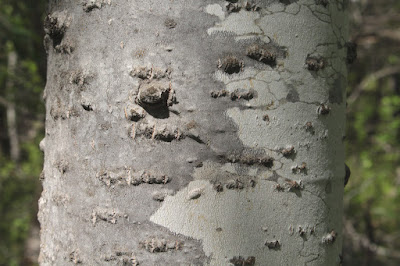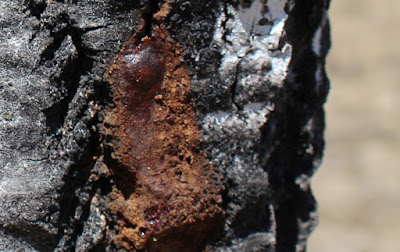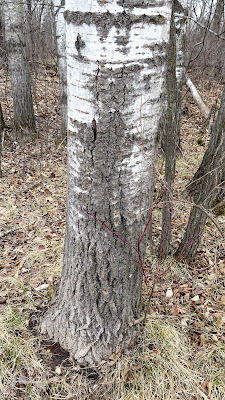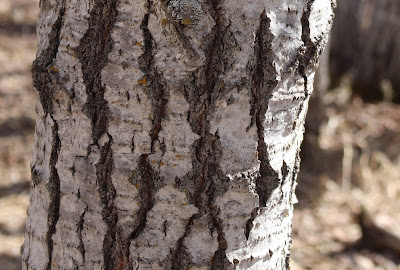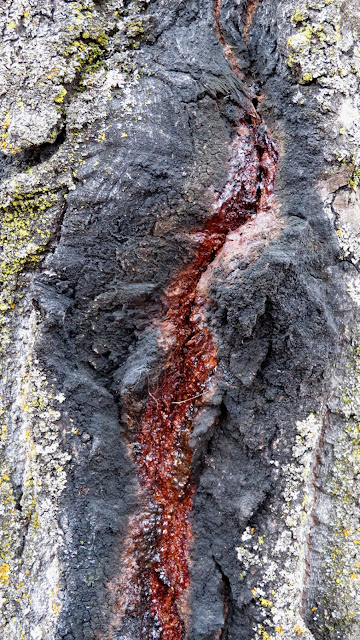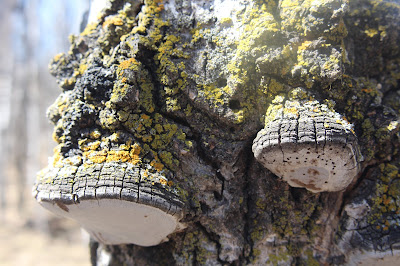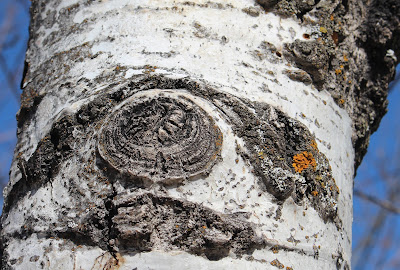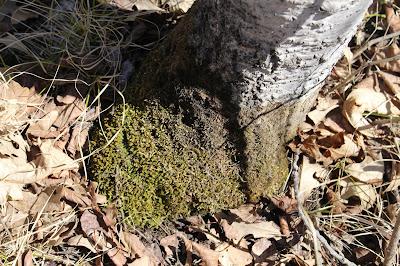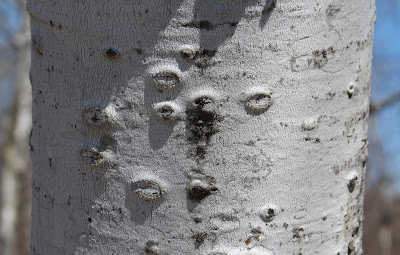Perhaps the most noticeable thing about aspens is the bark. The bark can make aspens beautiful, but black blotches on the bark as well as distorted limbs can also make these trees quite ugly.
This project started when on the trail I became curious about what caused aspen bark to have a white & black appearance. I suspected that it might be a fungus, but it seemed strange that every tree would be infected with it. I made a note to check it out when I got home. Of course, I forgot when I got home, and kept forgetting after additional walks. Eventually, I looked it up and found out about lenticels. This sparked my interest in learning more, and in taking more pictures.

When you examine the bark closely, you see lots of interesting things. Here's an Eaton's catalog of what I've found in the Assiniboine Forest. (I'm showing my age). I give brief explanations where I have any, and I speculate when an explanation is starting to take shape. Where I can't explain, I pose some questions, as a reminder to myself to look into these points further. Even without all the answers, it's a colourful photographic tour of the diversity of features that exists on or within the bark of just this one species, when you keep your eye out for the detail. It's a work in progress, and will keep changing for a while as I take new photos and gather more information.
The characteristics examined are:
The Not So White Aspen
Discoloration of the Bark
Aspen Sap on the Bark
Lenticels & Rings
Furrowed Bark
Black Blotches
Distorted Growth
Black Canker
Moss, Fungus, & Lichens, on Aspen
Trivia & Curiosities
Aspen Bark Mysteries
Click on Images to Enlarge
The Not So White Aspen
On the surface, aspen has a white bark that resembles that of birch trees, but it doesn't peel in the same way. The bark is photosynthetic, allowing the trees to continue growing after their leaves have dropped, and the photosynthesis is in fact the reason for the bark being white. In truth, aspen trees in the forest vary from bright white to grey to a light greyish green, and unless my camera is playing tricks on me, I detect a light brownish tint to some of the greyish trees. Does the greyish green, like the white, relate to photosynthesis? Here are some photos illustrating these colour variations:
A whiter shade of pale, as the song goes
Deeper in the woods, these young aspens have a light grey tone, perhaps because of the amount of shade.
And here, a slight brownish shade to the grey
Greenish-grey aspen trunks (on the right). The ones on the left have a brownish shade.
The bark generally seems to be whiter on the side that gets most light, i.e. usually the southern side. At other times the northern side seems to be the whitest. That could be explained by some trees being shaded on the southern side, but other trees seem to defy these explanations.
So much for the base colours. Now for an added level, discoloration on the surface of the bark, which at times may help to explain the above tones, but at times appears to be clearly something different.
Discoloration of the Bark
These blotches of grey or a greyish green at times look as if they were painted on by a house painter wiping the last of the paint out of an almost dry brush. Is this because the photosynthesis is in progress, changing the colour of the trunk?
These patches generally have crisp edges, suggesting that it's not caused by a fluid running down the tree - although the first photo seems to display both.
A greenish-grey discoloration on one side of the tree
Crisp edges and horizontal streaks of greenish grey on this tree
The patches here are grey
Another grey discoloration. In this case, it is on the south-western side of the tree, the side that would normally experience the most intense sunlight.
Aspen Sap on the Bark
Aspen sap can leech out from wounds on the trunk or branches, dripping down and leaving discolorations on the bark (not like the crisp patterns shown above). The wounds could have various sources - I have read about tree aphids and birds as possibilities, but as the photos suggest, it can happen at knots also, after a branch has broken off as a result of wind damage.
Aspen sap can be tapped and made into a syrup. The sap stains on the trunk to be an orange-red, green to olive green, or black as shown by the photos below. These photos definitely represent at least two different phenomena.
This wound has been dripping an orange-red sap.
Close-Up
Here on this sapling, the leeching shows its orange-red colour, but also suggests a greenish hue where the sap has thinned out on the bark.
This orange discoloration may be the result of the leeching of sap in the past.
Here, the darker discoloration seems to have a touch of orange in it, making it an olive green.
In the upper left, a darker olive green tone
This is the tree with the drip, as shown in the first two photos. The dried sap has left black stains running down the trunk.
More black streaks. These are on the surface; they are not cracks in the bark.
This is something different. The sap has apparently congealed into a heavy red-brown mass, without running down the trunk.
Close-Up
The same, on another aspen
Lenticels & Rings
The tiny holes in short horizontal lines on Aspen bark are
lenticels that serve as pores for gas exchange.
This Aspen bark shows several raised rings that extend part way around the bark. These appear to be related to the lenticels.
Furrowed Bark
With age, the lower areas of aspen bark become deeply furrowed, like that of oak, ash, and elm.
These trunks are furrowing in unison
Furrowing has begun on this bark
Black Blotches
The characteristic appearance of Trembling Aspen is its black on white appearance, the black areas being (for lack of a better name) what I will call black blotches. Trembling Aspens are plagued with them. Some of them can be quite unsightly.
Wounds on aspen bark can be initiated by several things, including fungal spores landing in lenticels, viruses, wind damage, extreme cold weather, drought, fire, insects, birds, vertebrates, and humans. Once the bark is wounded, fungi can move in and cause progressive damage. Aspens are cursed with fungal infections; in fact, there are over 150 of the culprits, not to mention that more than 300 types of insect prey on aspen.
Two of the fungal infections are covered under headings further below on this page. Black Canker, or Ceratocystis fimbriata, leaves a distinctive mark on the tree, with the vertical open wound (gall) exposing the inner wood, and not being healed by a callus. Phellinus tremulae, the fungus causing Aspen Bracket, is more difficult to distinguish as the cause of diseased bark, because the fungus lives in the tree for a long period before sending out its fruiting body (the bracket or conk).
A third type of fungus, not shown on this page, is Chaga, caused by the fungus Inonotus obliquus. Chaga is a somewhat bulbous black growth with a charcoal-like appearance, and is used by some foragers for making a tea. The black growth is not the fruiting body of the fungus, but a mass of mycelium.
However, these are just three of the fungi which cause the bark damage we see in the Assiniboine Forest. Although I may be able to identify the specific cause of some of the black areas in this bark exploration page, in general black blotch is about as scientific as I'll get.
In this aspen, there is a large fungal infection, and the lenticels have also been infected with airborne spores which have gained entry through the gas exchange holes.
This tree shows more fungal infection. The fungus has invaded not only the small lenticels, but the raised horizontal ring areas.
This is unusual. There are lichens present which influence the overall colour, but it does appear that these blotches are in fact brownish.
This infection started where a branch had broken off. Except underneath, it is smoother than most blotches.
About as bad as it gets
There is good news. Some trees appear to be relatively uninfected. Sometimes an entire grove of aspens appears to have dodged the bullet - perhaps because the parent tree and its offspring have greater resistance, as opposed to groves of infected trees which have weakened ability to resist the infections.
But.... if fungi cause trunk rot and eventually kill the trees, why are most Trembling Aspens beyond the sapling stage infected? Why does the aspen allow itself to be humiliated in this way? Why didn't natural selection cause the species to mutate into a more resistant tree? Did they in fact evolve, only to be outpaced by 150 species of fungi on the same natural selection train?
Distorted Growth
You can't fail to notice that some aspens have developed extreme contortions in their growth. These can occasionally be interesting and attractive. Usually they are downright ugly.
The following photos show badly distorted trees. The first two might suggest a possible genetic cause, although it could relate to disease. With the third and fourth it appears to be definitely the damage associated with the black blotches which caused the distortions.
Footnote: Cuttings from a grove of twisted aspens in Saskatchewan were propagated in Manitoba, and each showed the same twisted characteristics, suggesting that the cause is a genetic mutation. Trembling Aspens are rhyzomatic, with all child trees having the same genetic makeup as the parent tree. This explains why distorted trees can occur in groves.
However, the above photos are not in groves of distorted trees - they are isolated cases.
Black Canker
A canker is an area of diseased tissue, often sunken, on a trunk or branch. Many cankers develop around old branch stubs. Infections develop on recent wounds after as visit by an insect carrying spores from another canker. The discolorations in the following photos are a slow-developing disease named Black Canker, caused by the fungus Ceratocystis fimbriata. They are always vertical, and can be quite colourful.
A Black Canker has started on this aspen
This one is a little larger, and has opened up more, revealing the rotting wood within
A colorful close-up of the well-developed Black Canker on the above tree.
Aspen Bracket
Aspen Bracket, or False Tinder Conk, is the hard woody growth caused by Phellinus tremulae, a parasitic fungus that grows on Trembling Aspen and causes decay of the heartwood. The fungus starts with its spores landing on a wound such as an eye-shaped branch scar. (The wound could also have been due to other factors such as insects.)
As with other mushrooms, what you see on the outside is just the fruiting body of the fungus. The rest of the fungus is inside, doing its damage and causing brown rot. In fact, the fungus is already well established within the tree by the time the bracket appears. It's only the occasional tree in the Assiniboine Forest that has an aspen bracket, but when you do see one, you often see multiples on the tree.
Click
here for further information on Aspen Bracket by the J.J. Collette Provincial Natural Area (Alberta) foundation.
A pair of Aspen Brackets. Tiny holes under the bracket on the right suggest that it in turn has been invaded, presumably by insects.
Bracket fungi are perennials, and the annual growth is visible as layers in the woody fruiting body.
Powdered Orange Lichen finds a home on the swelling of the wood above this bracket fungus. The swelling was caused by the fungus.
An eye-shaped branch scar
An aspen trunk with multiple bracket fungi
Someone has attempted to smash pry off this bracket, revealing its inner structure.
Moss will grow on aspen trunks, although it seems to be limited to the 12 inches closest to the ground, perhaps because more moisture is available down there. Here are various types of moss on aspens. See the Mosses & Lichens page for more pictures.
Golden Ragged Moss on Trembling Aspen
Lichens on Aspen
This photo shows an apparently smooth orange growth on the bark of a dead aspen - but what type? I had originally thought that this was a mold (fungus), but as a result of a visible crystalline structure under high magnification, now believe that is some type of lichen.
Additional photos on the Lichens page
Some lichens are spread by
soredia, a fine dust composed of its inner material on its surface. In the photos below, it would appear that the windblown soredia have found it easy to gain a foothold in fungal damage areas, whereas they would not have found a home on the smoother bark surface.

Powdered Orange Lichen, Xanthoria fallax, a type of foliose (leaf) lichen found on trees, dead wood, and sometimes rocks.
Enlarged. The lichen has attached itself to areas of previous fungal damage.
Mustard Powder Lichen, peppered with a little orange lichen
A patch of white or silvery foliose lichen on Aspen
Trivia & Curiosities
Roots have bark, too. This is an exposed Trembling Aspen root.
When a Trembling Aspen dies, the photosynthesis stops and the bark loses its brightness.
Eventually, the bark of a dead tree starts to flake off.
Thin bark peeling from a dead Trembling Aspen
On some trees, the furrowed bark is broken up by areas of white bark which seem to be reluctant to try anything new.
The base of this tree has started to furrow into ribs, but a patch of unfurrowed white bark remains before the highly furrowed bark higher above.
This near pristine aspen of medium age has very little black blotching...
... while the bark on this badly diseased aspen suggests it is barely alive...
... yet it exhibits a very impressive array of catkins
On this tree, it appears that furrowed bark is forming on the northern side, while the southern side, facing the sun, remains white.
While some Trembling Aspen stands appear relatively unaffected by fungi, all the aspens in the vicinity of this particular tree suffer from the same infection.
This aspen has made a tasty meal for a deer. The underneath bark is nutritious.
Two adjacent trees with bark stripped. Deer like to feed on aspen bark at the edge of clearings (like this one) where they can keep an eye open for predators.
Aspen Bark Mysteries
What are the protruding eye-shaped rings on this aspen bark?
The same type of rings are visible on the right side of this badly-infected tree.
These wounds on Trembling Aspen bark suggest yet another type of infection.
This black blotch captured my curiosity because it looked different from the others, like foliose lichen. Is it just a weathered fungal blotch, or is it in fact lichen?
A few Trembling Aspen trunks exhibit what look like healed angular or even curved scars. Are these caused by insects? Fungus?
Or are they man-made?
The patterns on some trees appears almost graphic.
On some trees, black lines radiate out from infected spots on the bark.
This aspen features a smaller web of grey lines.








